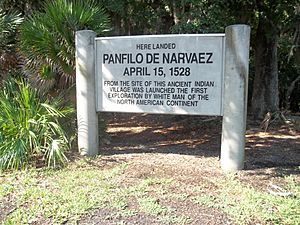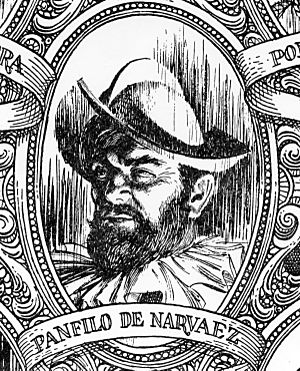Pánfilo de Narváez facts for kids
Pánfilo de Narváez (born around 1470 or 1478) was a Spanish explorer and soldier. He was known as a conquistador, which means a Spanish conqueror. He played a part in the early Spanish explorations of the Americas.
Narváez first traveled to Jamaica in 1510 as a soldier. Later, he helped conquer Cuba. He also led a group to Camagüey with Bartolomé de las Casas.
He is most remembered for leading two expeditions that did not go as planned. In 1520, he went to Mexico to stop Hernán Cortés. Cortés was invading the Aztec Empire without permission. Even though Narváez had more men, Cortés outsmarted him. Narváez lost an eye and was taken prisoner.
After two years, he returned to Spain. King Carlos V gave him a new mission. He was to explore and settle a place called La Florida. In 1527, Narváez sailed from Spain with five ships and 600 men. One of these men was Álvar Núñez Cabeza de Vaca. Cabeza de Vaca later wrote about the journey.
A big storm near Cuba damaged some of their ships. The rest of the group left Cuba in February 1528. They planned to go to the Rio de las Palmas in Mexico. But storms pushed them north to Florida instead. They landed in Boca Ciega Bay, near Tampa Bay.
Narváez decided to split his group. About 100 people stayed on the ships. The rest, about 300 men and 42 horses, traveled by land. They hoped to meet again at a large harbor to the north. But there was no such harbor. The land group and the ships never met again.
The land group walked north along the U.S. Gulf Coast. They tried to reach Pánuco in Mexico. They got to the St. Marks River, about 300 miles north. Narváez then ordered them to build boats. The 250 survivors sailed west along the coast.
A storm hit near Galveston Island. Most of the group drowned. About 80 people were washed ashore. Narváez and a small group were swept out to sea on a raft. They were never seen again. Over the next six years, almost all of the 80 survivors died. Only four men survived the Narváez expedition. They walked across Texas and Northern Mexico. They met other Spaniards in 1536. One survivor, Álvar Núñez Cabeza de Vaca, returned to Spain. In 1542, he published a book called Relacíon. It was the first book to describe the people, animals, and plants of inland North America.
Contents
Early Life and Family
Pánfilo de Narváez was born in Castile, Spain. He was born in either Cuéllar or Valladolid. His birth year was either 1470 or 1478. He was related to Diego Velázquez de Cuéllar. Velázquez was the first Spanish governor of Cuba. Narváez's nephew was Antonio Velázquez de Narváez.
A writer named Bartolomé de las Casas described Narváez. He said Narváez was "a man of authoritative personality." He was also "tall of body and somewhat blonde inclined to redness."
Adventures in Jamaica and Cuba
Narváez helped Spain conquer Jamaica in 1509. In 1511, he went to Cuba. There, he helped Diego Velázquez de Cuéllar conquer that island.
He led groups to the eastern part of Cuba. He was with Bartolomé de las Casas and Juan de Grijalva. De las Casas was there and saw what happened. Narváez was involved in a difficult event called the massacre of Caonao. Spanish soldiers harmed many native people in a village. These people had come to meet them with food. After this event, Narváez asked de las Casas what he thought. De las Casas was very upset by what had happened.
The Mexico Expedition
In 1519, Diego Velázquez de Cuéllar, the governor of Cuba, sent Hernán Cortés to Mexico. Velázquez paid for this trip. But soon, Velázquez worried that Cortés would not be loyal. He tried to call the expedition back. Cortés did not obey. He continued his plan to conquer the Aztec Empire.
Velázquez then named Narváez as the new governor of Mexico. He sent Narváez with 1,400 men on 19 ships. Their mission was to stop Cortés.
Narváez landed at Veracruz. Cortés had left a small group of soldiers there. Cortés himself had gone to the Aztec capital, Tenochtitlan. Cortés's captain, Gonzalo de Sandoval, captured some of Narváez's men. He sent them to Tenochtitlan to warn Cortés. Narváez could not defeat the small group. So, he set up camp in the Totonac town of Cempoala.
When Cortés heard about Narváez, he gathered his own soldiers. He had only about 250 men. He quickly returned to the coast. On May 27, 1520, Cortés's men attacked Narváez's camp in Cempoala. It was raining heavily. They quickly took control of Narváez's cannons and horses.
Narváez and his men fought at the main temple in Cempoala. Gonzalo de Sandoval arrived with more of Cortés's men. They set the temple on fire. Narváez and his men had to come out. Narváez was badly hurt. He lost his right eye from a pike. He was taken prisoner. He stayed a prisoner in Veracruz for two years. Then he was sent back to Spain.
Narváez's men were promised gold by Cortés. They joined Cortés's army. They went back to Tenochtitlan. There, they helped conquer the Aztec Empire.
During this time, a terrible disease called smallpox spread. It came from someone in Narváez's group. It spread to the native people of New Spain. Many people died from it.
The Florida Expedition
Narváez was later given a new title, adelantado, for Florida. This meant he was allowed to explore and settle the land. King Charles V gave him this title.
He left Sanlúcar de Barrameda, Spain, on June 17, 1527. He had five ships and 600 men. After reaching Cuba, a hurricane hit. Several ships were lost. Narváez gathered his remaining forces. In February 1528, he sailed with five ships, 400 men, and 10 women. They were heading for the Rio de las Palmas.
His ships ran aground. He decided to go to Havana for more supplies. But storms and strong winds pushed him north. He ended up on the west coast of Florida. The expedition arrived in April 1528. They were weaker from the storms and from men leaving the group.
They landed with 300 men near Tampa Bay. This spot is now called the Jungle Prada Site in St. Petersburg. They met native people who were not friendly.

Soon after landing, Narváez explored inland. He found the southern shore of what is now Old Tampa Bay. He continued along the coast. He reached the main village of the Tocobaga Indians. There, he found "many boxes from Castile" and other European items. Some historians think he might have found things left behind by Juan Ponce de León's settlement from 1521.
Narváez decided his landing spot was not safe for his ships. There was also no food nearby. So, he decided to split his group. The ships and the land group were to go north along the coast. His pilots told him there was a large bay nearby where they could meet. The land group had 300 men and 42 horses. Narváez led them.
But there was no large harbor north of where they landed. Narváez never saw his ships again. His group moved north through Florida. They reached the St. Marks River. This was the land of the powerful Apalachee Indians.
Narváez did not find the gold or riches he was looking for. The native people were also hostile. So, Narváez ordered his men to build four rafts. They hoped to reach their original destination, Panuco. He took one raft with the strongest men. Álvar Núñez Cabeza de Vaca, his second-in-command, led another.
About 240 survivors sailed west along the coast. A storm hit, and most drowned. About 80 survivors were washed ashore near Galveston Island, Texas. The native people either killed or captured the storm survivors. Only four of the 86 survivors escaped. The others were killed or starved.
Only four men survived the entire journey. They were Álvar Núñez Cabeza de Vaca, Andrés Dorantes de Carranza, Alonso del Castillo Maldonado, and an enslaved man from Morocco named Estevanico (Esteban). They had been held captive near Galveston Island for six years.
Cabeza de Vaca wrote a book called Relación. It described the journey of these four survivors. They walked across what is now the southwestern United States and northern Mexico. This trek took eight years from their landing in Florida. They finally reached Culiacán (Sinaloa) in Mexico. There, they found Melchor Díaz, who was the mayor and captain of the province.
See also
In Spanish: Pánfilo de Narváez para niños



